SYDNEY, AUSTRALIA — Australia’s 2020-21 winter crop production is forecast to increase 53% due to a 23% jump in the area planted, according to an Australian Bureau of Agricultural and Resource Economics and Sciences (ABARES) June report.
Peter Gooday, acting executive director of ABARES, said the opening to the winter cropping season in 2020–21 was favorable, especially in the eastern states and South Australia.
“Winter crop production is forecast be to be 44.5 million tonnes in 2020–21, which is 11% above the 10-year average to 2019–20,” Gooday said. “Yield prospects in New South Wales, Victoria and South Australia are forecast to be above average given favorable levels of soil moisture at the beginning of June and the likelihood of above-average rainfall in July.”
The ABARES report is based on assumed average seasonal conditions in spring as the Bureau of Meteorology outlook for spring is not yet available.
ABARES’ forecast lifts the area planted to winter crops in 2020–21 to 22.5 million hectares, which is 5% above the 10-year average to 2019–20 of 21.4 million hectares.
“The majority of this increase is expected to be in New South Wales, where seasonal conditions so far are much more favorable than during the last two winter crop seasons,” Gooday said.
Wheat’s area planted is forecast to total 13 million hectares, a 27% increase, ABARES said. Production of the commodity is expected to jump 76% to 26.7 million tonnes.
Barley’s area planted is forecast to rise 8% to approximately 4.4 million hectares. Its production is anticipated to increase 17% to 10.6 million tonnes.
“Falls in barley prices in early May occurred in the midst of planting but did not significantly change planting intentions in the eastern states with many producers maintaining planned crop rotations,” Gooday said.
ABARES noted increased production amongst winter other crops, canola production is forecast to increase by 40% to 3.2 million tonnes, chickpeas production is forecast to increase by 135% to 661,000 tonnes and oats production is forecast to increase by 81% to 1.6 million tonnes.
Gooday said the three-month seasonal outlook (June-August) issued by the Bureau of Meteorology on June 4 indicated winter rainfall is likely to be above average in most cropping regions in Queensland and New South Wales and around average in most other cropping regions.





